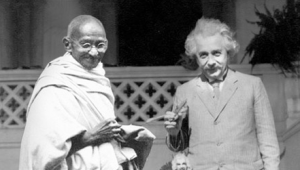Huddie Ledbetter, better known as “Lead Belly,” was one of the greatest blues musicians of all time. His songs have been covered by hundreds of artists, ranging from Frank Sinatra to Led Zeppelin. Lead Belly is also famous for what his biography at the Rock and Roll Hall of Fame describes as “the mythic outline of his life”:
Born circa 1885 in rural northwest Louisiana, Lead Belly rambled across the Deep South from the age of 16. While working in the fields, he absorbed a vast repertoire of songs and styles. He mastered primordial blues, spirituals, reels, cowboy songs, folk ballads and prison hollers. In 1917, Lead Belly served as Blind Lemon Jefferson’s “lead boy”–i.e., his guide, companion and protégé–on the streets of Dallas. A man possessed with a hot temper and enormous strength, Lead Belly spent his share of time in Southern prisons. Convicted on charges of murder (1917) and attempted murder (1930), Lead Belly literally sang his way to freedom, receiving pardons from the governors of Texas and Louisiana. The second of his releases was largely obtained through the intervention of John and Alan Lomax, who first heard Lead Belly at Angola State Prison while recording indigenous Southern musicians for the library of Congress.
In 1935 the March of Time newsreel company told the story of John Lomax’s discovery of Lead Belly in the short film above. Although the scripted film will strike modern viewers as dubious in some respects (March of Time founder Henry Luce once described the series as “fakery in allegiance to the truth”), the newsreel is nevertheless a fascinating document of Lead Belly, who was about 50 years old at the time, along with Lomax and Martha Promise, Lead Belly’s wife. At one point Lead Belly sings his classic song, “Goodnight, Irene.”
According to Sharon R. Sherman in Documenting Ourselves: Film, Video, and Culture, the 1935 Lead Belly newsreel is the earliest celluloid document of American folklore. Lead Belly did work for Lomax after his second release from prison, as the newsreel says, accompanying him back East to serve as his chauffeur. In New York Lead Belly performed in Harlem and also came into contact with leftist folk singers like Woody Guthrie and Pete Seeger. Lead Belly became known as the “King of the Twelve-String Guitar.”
Three Songs by Leadbelly, the only other film known to exist of the great bluesman, was made ten years after the newsreel. The footage of Lead Belly performing was shot in 1945 by Blanding Sloan and Wah Mong Chang, and edited two decades later by Pete Seeger. The film begins with scenes of the graveyard in Mooringsport, Louisiana, where Lead Belly was buried after his death in 1949, accompanied by an instrumental version (with humming) of “Where Did You Sleep Last Night?” Lead Belly actually performed six songs for the film, but only three could be salvaged. Seeger is quoted by Charles Wolfe and Kip Lornell in The Life and Legend of Leadbelly as describing Sloan’s work as “pretty amateurish”:
I think that he recorded Leadbelly in a studio the day before, then he played the record back while Leadbelly moved his hands and lips in synch with the record. He’d taken a few seconds from one direction and a few seconds from another direction, which is the only reason I was able to edit it. I spent three weeks with a Movieola, up in my barn, snipping one frame off here and one frame off there and juggliing things around. I was able to synch up three songs: “Grey Goose,” “Take This Hammer,” and “Pick a Bale of Cotton.”
If you would like to sign up for Open Culture’s free email newsletter, please find it here. Or follow our posts on Threads, Facebook, BlueSky or Mastodon.
If you would like to support the mission of Open Culture, consider making a donation to our site. It’s hard to rely 100% on ads, and your contributions will help us continue providing the best free cultural and educational materials to learners everywhere. You can contribute through PayPal, Patreon, and Venmo (@openculture). Thanks!
Related content:
Legendary Folklorist Alan Lomax: The Land Where the Blues Began
Hear 17,000+ Traditional Folk & Blues Songs Curated by the Great Musicologist Alan Lomax
The Story of Bluesman Robert Johnson’s Famous Deal With the Devil Retold in Three Animations


